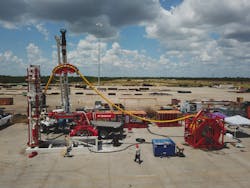Intelligent MPD features automated riser system
In 2019, Weatherford introduced Victus, the world’s first intelligent managed pressure drilling (MPD) system. MPD has been used for five decades as an effective strategy to manage pressure in challenging windows, to manage losses, to optimize drilling through management of effective circulating density (ECD), and to identify influxes and allow them to be circulated out. Victus takes the capabilities of MPD an important step further by bringing previously unheard-of intelligence to the MPD control system. This newly created intelligent MPD system predicts bottomhole pressure in real time based on surface measurements, therefore, it is able to replace early kick detection with early automated kick response.
The system’s response to an influx is analogous to a similar step forward in automotive safety and performance enhancement, the antilock braking system (ABS) response in a vehicle. The ABS system detects a potential problem, momentarily assumes control to ensure the vehicle slows or stops safely, and then reverts control to the operator once it is satisfied that the situation is made safe. In the case of an influx, the new MPD system helps the driller in the same way as the ABS system in a car helps the driver. In short, it is no longer necessary to use the BOP to control every influx.
One definition of an algorithm is effectively “wisdom encoded in a formula.” The core of the new control system includes a hydraulics model, based on a sound understanding and application of physical principles but trained using millions of hours of recorded MPD data, being many years of acquired wisdom, to allow it to accurately predict bottomhole pressure in the full spectrum of well conditions: temperature, pressure, mud conditions and properties, cuttings loading, etc. Thus, the model combines key physical principles with advanced data analytics.
The physical principles ensure that the model is grounded in reality, and the use of data analytics allows fine tuning of the physical models to account for and incorporate real data from wells globally. Provided that there is a sound understanding of the physics involved, and provided that sufficient data exists to allow the use of analytics to train the models, this is a much more rigorous and successful approach than using physics alone or than simply building data-dependent models based on conditional probability. Weatherford leveraged its many years of experience in hydraulics modeling, together with data from 50 years of MPD jobs, to create such a hybrid model. The resulting intelligent algorithm has been tested in a variety of applications and the control system used within is certified by DNV GL.
The intelligent control system is applicable to any MPD application, whether onshore or offshore (shelf to deepwater). But for deepwater applications, Victus is further enhanced by a new generation automated MPD riser system. This riser system effectively replaces the first riser joint, below the tension ring, and incorporates a smart rotating control device (RCD) that enables predictive maintenance and early leak detection. The system also includes the flow spool and an annular isolation device (AID) capable of completely shutting off the annulus.
Customer feedback from an earlier generation MPD riser system revealed that installation and commissioning took too long, as much as two days, negating the beneficial effects of MPD on penetration rate and drilling efficiency. In addition, from a health and safety perspective, the installation required personnel in the moonpool during the operation. To address this feedback, the company created a new flow spool with a single connection hub that integrates a subsea control umbilical and flowlines into one easy-to-connect component to allow rapid connection and disconnection of the hub. A proven, automated, remote controlled, robotic arm is used to make this connection. The use of an existing, proven, arm design reduced risk in the project and ensures reliability of the system. The robotic arm allows all manual work, and therefore all personnel, to be eliminated from the moonpool during this operation. The combination of robotic arm and the single connection hub reduces the installation time from two days to less than 20 minutes, allowing the operator to realize all of the time savings associated with MPD. In addition, a subsea surveillance system enables visual monitoring of the riser module and reduces ROV usage. A single subsea control umbilical provides high-performance fiber-optic cables for fast and reliable data transmission.
The first new generation Victus riser module was completed in early 2019 and then subjected to extensive testing. The MPD riser test program was prepared in accordance with the latest API specifications relating to drilling riser systems, primarily API 16RCD for the RCD, API 16A for the AID, flow spool and cross over systems, and API 16C for the auxiliary lines. The latest edition of API 16A has been heavily revised from prior versions with an expanded and much more rigorous scope and the testing of the new MPD riser was accordingly rigorous.
Multiple tests carried out at the company’s engineering test facility in Houston included body and shell proof testing, hydraulic chamber testing, sealing characteristics, RCD stripping life tests, and fatigue testing. An external test facility was engaged to safely conduct the required temperature testing: low temperature design validation; low temperature drift; continuous operating temperature design validation; and an extreme high temperature design validation. Historically, a significant challenge for the industry is the completion of full-closure pressure testing, or complete shutoff testing. These challenging tests were successfully navigated, proving vital functions of the MPD riser.
Additionally, RCD sealing elements must survive multiple tool joints being run through them to ensure that the life of the sealing element does not compromise operations by being shorter than the life of the drill bit. Rigorous finite element analysis studies can predict fatigue performance of the sealing element, and the materials from which it is made, but the best way to learn and develop reliable equipment is to test for failure and rapidly learn from it. To this end, the engineering team allocated the time and resources required to develop a custom stripping test fixture to accelerate that testing and ensure the reliability, integrity, and cost effectiveness of the RCD seal.
Testing of the installation system including the flow spool, the robotic arm, and the connection hub was completed off site in Estonia. After all component and sub-system testing was complete and all items were shaken down and proven to pass individual tests, a complete factory acceptance test on a fully assembled riser system, including the robotic arm, was conducted at the company’s facility in Katy, Texas. Both DNV GL and ABS witnessed and signed off on every test step.
By the end of the year, the Victus intelligent MPD riser and control system is expected to be used for the first time in the Shafag Asiman field in the Azeri sector of the Caspian Sea. This first use will be a big step in revolutionizing MPD. •
The Author
John Clegg is a Weatherford Fellow, in the Drilling domain. For more than 33 years he has worked in multiple countries in engineering, manufacturing, sales and operations with upstream technologies including drill bits, drilling motors, rotary steerable tools, MWD, LWD, and MPD. He holds a master’s degree in Engineering Science from Oxford University. He has 14 patents, has authored multiple technical papers, and sits on two Technical Section Boards for the Society of Petroleum Engineers.


